
Prince Jerzy Ossoliński h. Topór was a Polish nobleman (szlachcic), Crown Court Treasurer from 1632, governor (voivode) of Sandomierz from 1636, Reichsfürst since 1634, Crown Deputy Chancellor from 1639, Great Crown Chancellor from 1643, sheriff (starost) of Bydgoszcz (1633), Lubomel (1639), Puck and Bolim (1647), magnate, politician, statesman and diplomat. Famous for being extensively educated, he was a skillful politician and a persuasive public speaker.

Jan Sariusz Zamoyski was a Polish nobleman, magnate, statesman and the 1st ordynat of Zamość. He served as the Royal Secretary from 1565, Deputy Chancellor from 1576, Grand Chancellor of the Crown from 1578, and Great Hetman of the Crown from 1581.

Prince Hieronim Augustyn Lubomirski (1647–1706) was a Polish noble (szlachcic), magnate, politician and famed military commander. He was a Prince of the Holy Roman Empire SRI.

Prince Karol Stanisław Radziwiłł was a Polish-Lithuanian nobleman and diplomat.
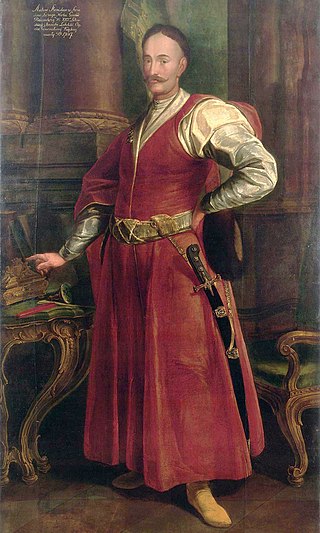
Stanisław Antoni Szczuka h. Grabie was a Polish noble (szlachcic), talented politician and political writer.
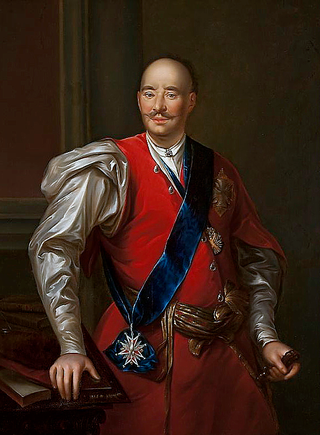
Franciszek Salezy Potocki (1700–1772) was a Polish nobleman, diplomat, politician and knight of the Order of the White Eagle, awarded on August 3, 1750, in Warsaw. Potocki was the wealthiest magnate of his time and the owner of large properties in Dnieper Ukraine, then part of the Polish Crown. Nicknamed "Little King of Ruthenia".
Rafał Leszczyński from the Leszczyński family of Counts of the Holy Roman Empire, was a Polish nobleman (szlachcic), father of King of Poland Stanisław I Leszczyński.

Prince Dominik Mikołaj Radziwiłł was a Polish–Lithuanian nobleman (szlachcic) and politician.
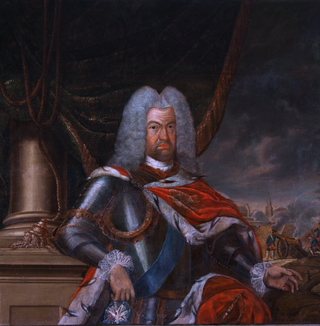
Count Franciszek Wielopolski was a Polish noble (szlachcic).
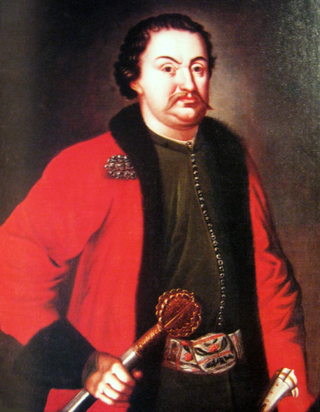
Marcin Zamoyski was a Polish nobleman (szlachcic).
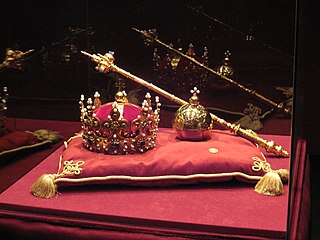
The only surviving original piece of the Polish crown jewels from the time of the Piast dynasty is the ceremonial sword Szczerbiec. It is currently on display along with other preserved royal items at the Wawel Royal Castle Museum in Kraków.
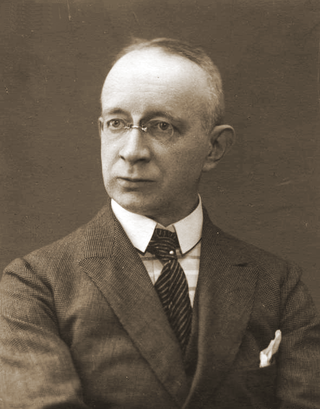
Stanisław Kętrzyński was a Polish historian, diplomat and freemason.

Mikołaj Sieniawski was a notable Polish magnate, military commander and a prominent politician of his times. He built stone Brzeżany Castle round which the modern town of Berezhany has developed.

Kazimierz Leon Sapieha (1609–1656) was a nobleman of the Grand Duchy of Lithuania, a part of the Polish–Lithuanian Commonwealth, Royal Secretary and Grand Writer of Lithuania from 1631, Court Marshal of Lithuania from 1637, Deputy Chancellor of Lithuania from 1645.

The Battle of Chojnice, also known as the Battle of Konitz, was a surprise nighttime attack followed by a run-and-chase battle during The Deluge.

Aleksander Michał Paweł Sapieha of Lis coat of arms was a noble of the Polish–Lithuanian Commonwealth.

The Constitution of 3 May 1791 is an 1891 Romantic oil painting on canvas by the Polish artist Jan Matejko. It is a large piece, and one of Matejko's best known. It memorializes the Polish Constitution of 3 May 1791, a milestone in the history of the Polish–Lithuanian Commonwealth and a high point of the Polish Enlightenment.
Agnieszka Biedrzycka is a Polish historian and writer from the Institute of History of the Polish Academy of Sciences (PAN). She obtained her doctorate in December 2002 from the Faculty of History of the Jagiellonian University in Kraków, Poland. Biedrzycka serves as research scientist and editor for the multi-volume Polish Biographical Dictionary published by PAN incrementally. She is in charge of the History of Poland in the Early Modern era department. Since the 1989 return to democracy from under the Soviet-led totalitarian control, many distortions printed there have already been corrected. Her professional interest in research work gave impetus to the book about the history of Lwów in the Second Polish Republic before the invasion of Poland, which was followed by the systematic destruction of the city's Polish heritage by the Soviet Union.
The Battle of Shmankivtsi took place between the troops of the Polish–Lithuanian Commonwealth and the Ottoman Empire near the village of Shmankivtsi. It ended with the victory of the combined forces of the Commonwealth.

The interior of the Tomb ofKing Casimir the Great is an oil on cardboard painting finished by Jan Matejko in 1869. This painting is located in Jan Matejko House, a branch of the National Museum in Kraków.

















